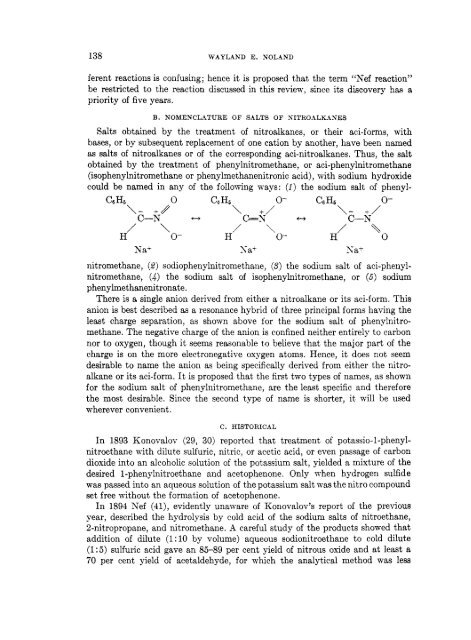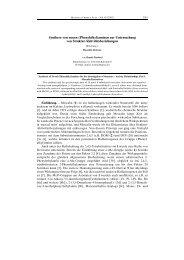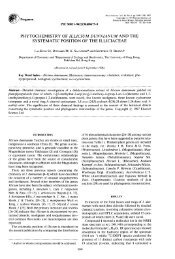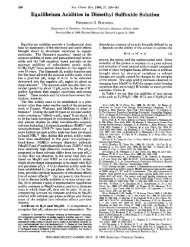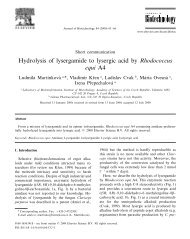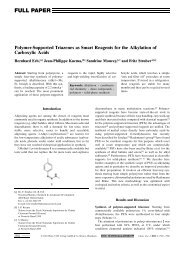Nef reaction
Nef reaction
Nef reaction
You also want an ePaper? Increase the reach of your titles
YUMPU automatically turns print PDFs into web optimized ePapers that Google loves.
138 WAYLAND E. NOLAND<br />
ferent <strong>reaction</strong>s is confusing; hence it is proposed that the term “<strong>Nef</strong> <strong>reaction</strong>”<br />
be restricted to the <strong>reaction</strong> discussed in this review, since its discovery ha;r a<br />
priority of five years.<br />
B. NOMENCLATURE OF SALTS OF NITROILIC4NES<br />
Salts obtained by the treatment of nitroalkanes, or their aci-forms, with<br />
bases, or by subsequent replacement of one cation by another, have been named<br />
as salts of nitroalkanes or of the corresponding aci-nitroalkanes. Thus, the salt<br />
obtained by the treatment of phenylnitromethane, or aci-phenylnitromethane<br />
(isophenylnitromethane or phenylmethanenitronic acid), with sodium hydroxide<br />
could be named in any of the following ways: (1) the sodium salt of phenyl-<br />
Ca Hg 0 Ca H5 0- C-5 H6 0-<br />
\- +//<br />
C-K<br />
/ \<br />
H 0-<br />
c+<br />
\ +/<br />
c=?; f-,<br />
/ ‘\\<br />
H 0-<br />
\- +/<br />
C-N<br />
/ \<br />
H 0<br />
Ea+ Sa+ Sa+<br />
nitromethane, (2) sodiophenylnitromethane, (3) the sodium salt of aci-phenyl-<br />
nitromethane, (4) the sodium salt of isophenylnitromethane, or (6) sodium<br />
p henylme t haneni tr ona te .<br />
There is a single anion derived from either a nitroalkane or its aci-form. This<br />
anion is best described as a resonance hybrid of three principal forms having the<br />
least charge separation, as shown above for the sodium salt of phenylnitro-<br />
methane. The negative charge of the anion is confined neither entirely to carbon<br />
nor to oxygen, though it seems reasonable to believe that the major part of the<br />
charge is on the more electronegative oxygen atoms. Hence, it does not seem<br />
desirable to name the anion as being specifically derived from either the nitro-<br />
alkane or its aci-form. It is proposed that the first two types of names, as shown<br />
for the sodium salt of phenylnitromethane, are the least specific and therefore<br />
the most desirable. Since the second type of name is shorter, it will be used<br />
wherever convenient.<br />
C. HISTORICAL<br />
In 1893 Konovalov (29, 30) reported that treatment of potassio-l-phenyl-<br />
nitroethane with dilute sulfuric, nitric, or acetic acid, or even passage of carbon<br />
dioxide into an alcoholic solution of the potassium salt, yielded a mixture of the<br />
desired S-phenylnitroethane and acetophenone. Only when hydrogen sulfide<br />
was passed into an aqueous solution of the potassium salt was the nitro compound<br />
set free without the formation of acetophenone.<br />
In 1894 <strong>Nef</strong> (4S), evidently unaware of Konovnlov’s report of the previous<br />
year, described the hydrolysis by cold acid of the sodium salts of nitroethane,<br />
2-nitropropane, and nitromethane. A careful study of the products showed that<br />
addition of dilute (1:lO by volume) aqueous sodionitroethane to cold dilute<br />
(1 : 5) sulfuric acid gave an 85-89 per cent yield of nitrous oxide and at least a<br />
70 per cent yield of acetaldehyde, for which the analytical method was less


